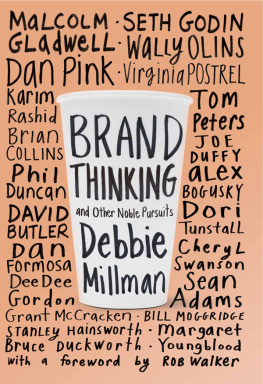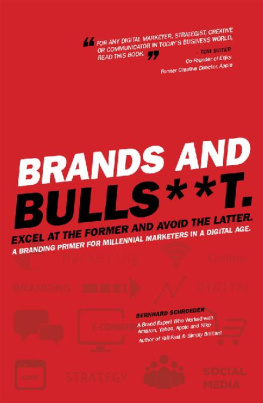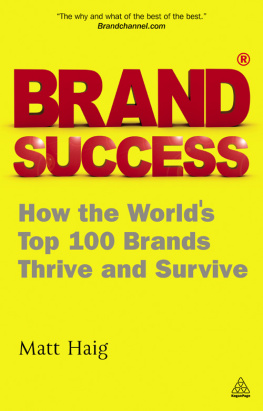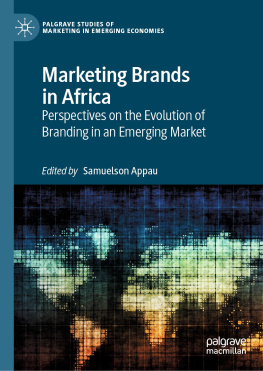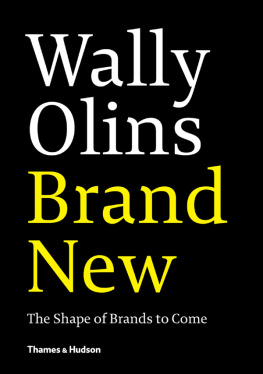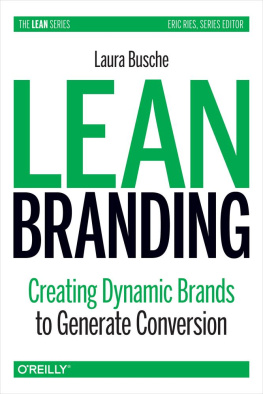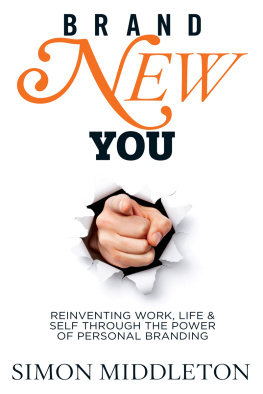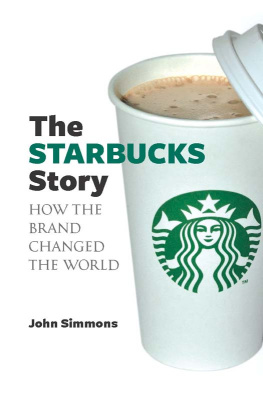

2011 BY DEBBIE MILLMAN
ALL RIGHTS RESERVED. COPYRIGHT UNDER BERNE COPYRIGHT CONVENTION, UNIVERSAL COPYRIGHT CONVENTION, AND PAN AMERICAN COPYRIGHT CONVENTION. NO PART OF THIS BOOK MAY BE REPRODUCED, STORED IN A RETRIEVAL SYSTEM, OR TRANSMITTED IN ANY FORM, OR BY ANY MEANS, ELECTRONIC, MECHANICAL, PHOTOCOPYING, RECORDING OR OTHERWISE, WITHOUT THE EXPRESS WRITTEN CONSENT OF THE PUBLISHER, EXCEPT IN THE CASE OF BRIEF EXCERPTS IN CRITICAL REVIEWS OR ARTICLES. ALL INQUIRIES SHOULD BE ADDRESSED TO ALLWORTH PRESS, 307 WEST 36TH STREET, 11TH FLOOR, NEW YORK, NY 10018.
ALLWORTH PRESS BOOKS MAY BE PURCHASED IN BULK AT SPECIAL DISCOUNTS FOR SALES PROMOTION, CORPORATE GIFTS, FUND-RAISING, OR EDUCATIONAL PURPOSES. SPECIAL EDITIONS CAN ALSO BE CREATED TO SPECIFICATIONS. FOR DETAILS, CONTACT THE SPECIAL SALES DEPARTMENT, ALLWORTH PRESS, 307 WEST 36TH STREET, 11TH FLOOR, NEW YORK, NY 10018 OR .
15 14 13 12 11 5 4 3 2 1
PUBLISHED BY ALLWORTH PRESS
AN IMPRINT OF SKYHORSE PUBLISHING
307 WEST 36TH STREET, 11THFLOOR, NEW YORK, NY 10018.
ALLWORTH PRESS IS A REGISTERED TRADEMARK OF SKYHORSE PUBLISHING, INC., A DELAWARE CORPORATION.
WWW.ALLWORTH.COM.
COVER DESIGN BY RODRIGO CORRAL
INTERIOR DESIGN BY RODRIGO CORRAL DESIGN
LETTERING ON COVER BY DEBBIE MILLMAN
EDITED BY JEREMY LEHRER
ISBN: 978-1-58115-864-9
MILLMAN, DEBBIE.
BRAND THINKING AND OTHER NOBLE PURSUITS / DEBBIE MILLMAN.
P. CM.
ISBN 978-1-58115-864-9 (PBK.)
1. BRANDING (MARKETING) 2. BRAND NAME PRODUCTS. 3. INDUSTRIAL
DESIGNERSINTERVIEWS. 4. JOURNALISTSINTERVIEWS. I. TITLE.
HF5415.1255.M55 2011
658.827DC23
2011030117
PRINTED IN THE UNITED STATES OF AMERICA
For Simon Williams, with gratitude and love


Strictly speaking, brands do not exist. you cant extract them from the earth, craft them in a workshop, manufacture them with industrial robots in a state-of-the-art facility, or fabricate them with a 3-D printer. you cant put one in your pocket, grow it on a farm, put a fence around it, fling it through a window, or leave it at a restaurant by accident. you cant even download a brand. A brand is nothing but an idea.
Wait: Dont ideas exist? well, sure. But only by way of a kind of mutual agreement. Thats the case with any idea, such as Christianity, participatory democracy, modernity, or market capitalism. Speaking of capitalism, the fact that brands do not exist does not mean brands are worthless; indeed, they have value that cant be deniedunless, of course, you dont believe in the idea of money. This is why the stakes around branding are so high in todays marketplace, and thus why so many genuinely smart people enmesh themselves in the business of figuring out how to do it right.
Debbie Millman has rounded up a rather impressive cross section of such practitioners to discuss and debate, among other things, what it means to do just that. The result is a consistently insightful collection of conversations about branding, one that should be illuminating to new students of the form as well as hardened practitioners and everyone in between. Im forever meeting people who think a brand means nothing more than a logo, or that it merely encompasses TV ads; perhaps now I can carry around this book, and hand it over by way of explanation.
Probably everybody has his or her own definition of brands and brandingyoull certainly find its been defined in a number of ways in Brand Thinking. My view is that branding is the process of attaching an idea to some object, or to a service or organization. That idea can be fairly straightforward: This brand of oats (or car or hammer) is of dependable quality. Or the idea can be extremely ambitious: This brand of mobile phone (or denim or yogurt) possesses and reflects a maverick and creative worldview.
Creating these kinds of associations is a complicated process, involving design, anthropology, advertising, public relations, semiotics, and, of course, the often-overlooked factor of tangible reality. (If your airlines planes fall from the sky on a regular basis, that defines your brand, no matter how cutting edge your socialmedia strategy, award-winning your advertising, or appealing your logo may be.) All those disciplines, and more, are represented in the interviews that follow; youll read the views of professionals within companies, those who advise them, journalists and thinkers who write about them, and gurus who aim to extract larger points from all of the above.
Often the views expressed vary and even clash, as well they should. Branding is the sort of topic that practically demands disagreement if its going to be talked about seriously. But while I might have different opinions on this or that subject than some of the interviewees do (actually, Im not even sure Im willing to go along with the implications of this books subtitle!), I arrived at the end of the collection having learned quite a bit. you will, too. Because this book is no rote anthology of boilerplate lectures. Its more like a buzzing dinner party, where you never know who is going to say what.
Millman is the ideal host to choreograph these discussions. This isnt just because, as president of design at Sterling Brands, she is an esteemed professional herself, or because she has established a track record of conducting thoroughly researched and provocative interviews in her Internet radio program Design Matters. Its because on some level these arent interviews at all: Theyre conversations. Shes engaged with her subjects, she listens, she pushes back, she shows surprise, she gets people to move past their standard talking points. Reading the resulting conversations is like following her through the party, eavesdropping as she works the room.
While a distinct optimism runs through the book, theres also enough friction at the edges to keep it lively, and challenging. As much as the reader learns, he or she is also, finally, left to think through the numerous issues and draw original, individual conclusions. For starters, youll likely end up crafting your own definition of brands and branding from the many variations offered here. wally Olins sets the tone by pointing out, It is ludicrous to think that advertising is the only way in which an organization can communicate who or what it is. Ill leave it to you to discover Olins definition in the pages ahead, but first, a few other perspectives: Brands are a ubiquitous part of our culture. Everyone interacts with them, everyday, Brian Collins points out in one of the dialogues. Brands are totems, argues Cheryl Swanson in another. People who are honest about branding understand that the Catholic Church is, by definition, a brand, asserts Seth Godin in a third.
A striking number of thinkers in this book connect the brand idea to the tribal instinct, and some connect elements of branding to the nature of human-ness itself. And youll even find some challenges to the practice: we dont need to have branded water, Dori Tunstall states flatly in her conversation with Millman.
I came to my own definition as a result of stumbling upon the brand as a subject of journalistic interest, rather than stalking it as an aspiring strategist. That is, I came to it as one of those peoplejust like those who frustrate me todaywho initially shrugged off branding as some trivial matter of symbols and slogans that didnt amount to much. years of reporting and thousands of written words later, Ive obviously changed my mind about that. Ive learned a lot, and thanks to books like this one, Im learning still. Brands exist in the minds of people who interact with them, Brian Collins observes in his interview. I couldnt agree more. And for better or worse, this is exactly why branding matters.
Next page
